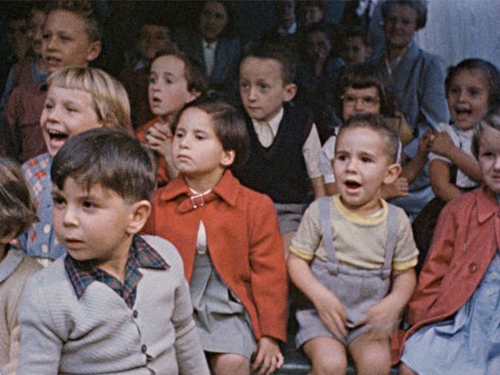
Art Cinema OFFoff presents a 16mm open-air program of five films in the outdoor theater of the Citadelpark. This free evening is part of Publiek Park – a four-day open-air exhibition (July 1-4), organized by the Young Friends v/h S.M.A.K., which brings together visual art, performance, music and cinema at the crossroads of culture, nature and heritage. OFFoff was invited to program the film section and made a selection of work that takes place in parks or forests. Each film, in its own way, explores the theatrical character of the public space, choreographing and rhythmitizing the movements within it.
The filmmakers in the program were all active in the American avant-garde of the 1940s and 1950s, but Paris is never far away. It was the home of Kenneth Anger during the 50s, Shirley Clarke filmed In Paris Parks there and Joseph Cornell felt an inspiring sense of nostalgia for France, a country he never visited. The tour through the various parks and forests in the program reveals many echoes, recurring motifs and crossing paths. Gradually, night falls in the series of films that become more and more mysterious and artificial. Each of the films has a dreamlike quality and shows the park as a place where magic is possible.
Program:
In Paris Parks (Shirley Clarke, 1954) - 14’
Dancer and filmmaker Shirley Clarke captures the rhythm of a day in a Paris city park between morning and sunset. In Paris Parks begins in the Luxembourg Gardens where her ten-year-old daughter, Wendy Clarke, rolls a hoop that will come to rest there again at the end of the film. In Paris Parks is a choreography of the everyday activity, dynamics and movement in a public park: the elderly play cards or sleep on a bench, children watch a puppet show, feed animals or take a ride on the merry-go-round. Clarke made In Paris Parks shortly after a first meeting with Maya Deren. With this film, she wanted to show that a dance film could be made without anyone on-screen actually dancing. The music of the American recorder virtuoso LaNoue Davenport rhythms the images.
Nymphlight (Joseph Cornell & Rudy Burckhardt, 1957) - 8’
A meditation on an ephemeral day in the life of a park. Twelve-year-old ballet student Gwen Thomas wanders the famous Bryant Park at the New York Public Library that serves as a stage set for a fantasy. Like a nymph at the large park fountain, she dreams away at the fleeting aerial ballet that the pigeons perform. Fiction and lyrical document blend in a daydream about the poetry of the everyday. This silent reverie seems related to the scenes in the shadow boxes for which Joseph Cornell is best known as a visual artist. From found and collected objects he assembled miniature theaters of dreams or memories, but also series about ballet and birds. The Swiss filmmaker and painter Rudy Burckhardt, especially renowned for his street photos of New York, is the eye behind the camera.
A Study in Choreography for Camera (Maya Deren, 1945) - 3’
Maya Deren films African-American dancer Talley Beatty as he performs a short dance sequence. Through editing and camera movement, she frees the dancing body from the traditional confines of theatrical – and actual – space. Beatty’s movements flow effortlessly between four disparate locations: a forest, Deren’s loft, the Egyptian Hall of the Metropolitan Museum and the Palisades cliffs. The thin silver birch trees resonate with the human body. For Deren, everything that is in the image frame is part of the choreography, not only the dancer, but also the entire space, the trees, the animate and inanimate objects. Beatty, she says, moves in “a world of the imagination in which, as in our day or night dreams, a person is first in one place and then in another without traveling.” Deren’s Bolex camera is a partner in this dance.
Eaux d'artifice (Kenneth Anger, 1953) - 13’
In Eaux d’artifice, a mysterious figure enters the gardens of Villa d’Este in Tivoli. This apparition in eighteenth-century costume wanders through the nocturnal labyrinth of waterfalls, balustrades, caves and fountains, that appear all the more overwhelming because of the small stature of the guest. Anger recorded in natural daylight with a red filter on black-and-white film, but developed the images on color stock with a blue filter for an artificial nighttime effect. He hand-painted the character’s green fan himself. The way the light plays on the shimmering and sparkling water contrasts strongly with the dark background and creates an elegant abstraction. Light, color, movement and texture are combined in a baroque counterpoint to the winter concerto of Vivaldi’s Four Seasons.
Rabbit’s Moon (Kenneth Anger, 1950/1971) - 16’
In Rabbit’s Moon, Kenneth Anger combines Japanese and Aztec moon mythology with the classic characters of the commedia dell’arte. The clown Pierrot tries to catch a Méliès-like moon and then to court the image of the beautiful Columbine that Harlequin projects with a magic lantern, but desires always remain unattainable. A letter from Jean Cocteau brought Anger to Paris, where he recorded Rabbit’s Moon in 1950 in Jean-Pierre Melville’s studio with actors from the Marcel Marceau mime school. Anger was able to work on 35mm nitrate film for the only time in his career and created an artificial forest with trees painted part silver, part black and leaves from reflective crystal paper. It evokes the texture of the fairytale forest that was built in the Warner Brothers studio for A Midsummer Night’s Dream (1935), a film in which Anger, according to his own myth, had played the part of a little prince as a child.
(All texts by Art Cinema OFFoff)

